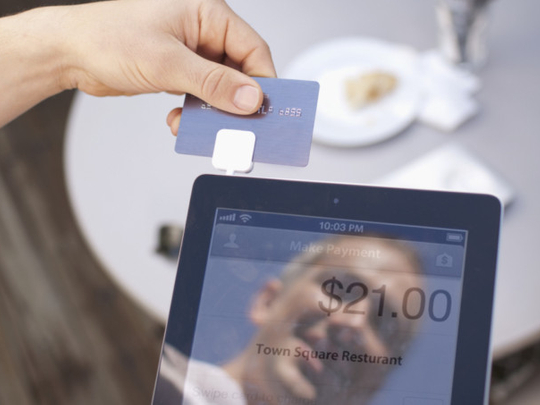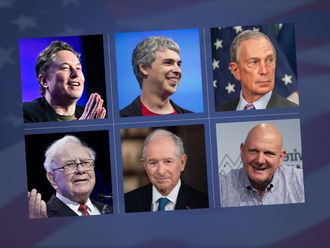
The UAE, an affluent society, has seen a number of credit-card innovations in the past. GN Focus has previously reported on scented credit cards, cards with tactile or translucent elements, biodegradable cards and others with individual artist designs.
This, however, is just about how a card looks and feels. In the future, more can be expected with high-tech elements being integrated into credit cards or a card being integrated into a high-tech gadget. Here are a few trends that are currently being worked on by credit card firms, entrepreneurs and innovators.
Keyboards and displays
MasterCard has developed what it calls a display card, which is a credit card equipped with a display and a small keyboard with touch-sensitive buttons. When the card is used, the display shows a one-time password that the user needs to type into the keyboard to authenticate a purchase. While the system is not new in the banking industry, where one-time passwords are widely used and generated by dongle-like devices, it is the first time that the system is used with a credit card and gives an idea of what a display on a card could do in the future.
“This card could incorporate additional functionalities and be able to indicate other real-time information, such as available credit balance, loyalty or reward points, recent transactions and other interactive information,” Matthew Driver, President South East Asia, MasterCard Worldwide, said at the recent launch of the card with Standard Chartered Bank in Singapore.
Biometric credit cards
The next step in maximum security for a credit card is biometric recognition and identification of the owner. This can happen through fingerprint recognition, retinal recognition, hand or finger geometry and facial feature recognition. Companies such as Seiko Epson have developed ultra-thin fingerprint readers that can easily be incorporated into a variety of commonly used items, among them credit cards. A non-matching fingerprint would render a card unusable, preventing abuse in the case of loss or theft. A number of start-ups in the US are working on the technology — Houston-based Epic One combines fingerprint authentication with the creation of a one-time security code by an embedded processor to guarantee the highest safety possible. Another security feature for the future is voice-controlled cards, meaning that the card will only be unlocked for use after the owner speaks out a certain key phrase or password.
Another innovation will be an invisible credit card made of special materials that does not show any card details until they are revealed through fingerprints or other ways of identification of the owner.
Ready to wear
Credit-card chips enabled with near field communication (NFC) or radio-frequency identification (RFID) will in the future be integrated into gadgets such as smart watches and other accessories, and use contactless payment systems such as Visa’s PayWave or MasterCard’s PayPass. Such gadgets just need to be tapped briefly against a reader and a payment is processed. The credit card information can also be on a small sticker or tag and be attached basically anywhere. Mashreq has recently launched a small sticker as a mobile wallet in the UAE that, for instance, can be attached to the back of a smartphone, transforming it into a credit card. Smartphone apps as such can make a smartphone into a wallet by storing a virtual credit card.
A most elegant solution was recently put forward by Australian tailor M.J. Bale and Heritage Bank, who presented a contactless payment suit this month. A Visa PayWave payment chip has been sewn into the sleeve of this Merino wool suit. Anyone wearing this suit just needs to tap their sleeve onto a reader and a payment is made. The tailoring company believes it has invented the ultimate lifestyle tool. “It gives men the ability to pay for anything with the effortless swagger of a celebrity, tycoon or double agent,” said Matt Jenson, CEO of M.J. Bale, at a presentation in Sydney.
Keyless entry devices
German automaker BMW is at the forefront of developing a car key of the future that does not only unlock and start a car remotely, but will have many other wireless functions, including contactless payment. Using NFC, BMW together with NXP Semiconductors has developed a key that allows payments for shopping, drive-in restaurants and hotel bookings, buying tickets for an event, payments for fuel or road tolls — including drive-through fast lanes — and parking fees, and many more scenarios where one normally pays with cash or uses a card.
The functions of the key can even be enhanced to get software updates for the car or integrate key access features to open one’s home or office or even hotel rooms.
“With the concept of integrating a contactless payment functionality in a car key, we are working on the combination of automotive technology and lifestyle,” says Raymond Freymann, Managing Director of BMW Group Research and Technology.
“In cooperation with NXP, we are doing research in enhancing the capabilities of the car key into one smart device for access, payment and services that will simplify the lives of BMW car drivers in the future. It will help us to stay in touch with our drivers directly and deliver a complete range of mobility-enhancing services,” he adds.
Credit-card reader apps
While credit card apps on smartphones have already reached a certain degree of popularity, the next step is credit card reader apps that give merchants more independence from stationary card readers and internet connections in their shops.
Merchants on the go can use a growing number of iPhone/iPad, Android and Blackberry applications on their smartphones to collect credit card data with or without a connected swiping device or dongle, when they are at trade shows, at a fair or when travelling.
Such apps often have additional features that allow for customer data tracking, emailing or messaging of receipts, handling of refunds and recording transactions offline when out of wireless coverage.










